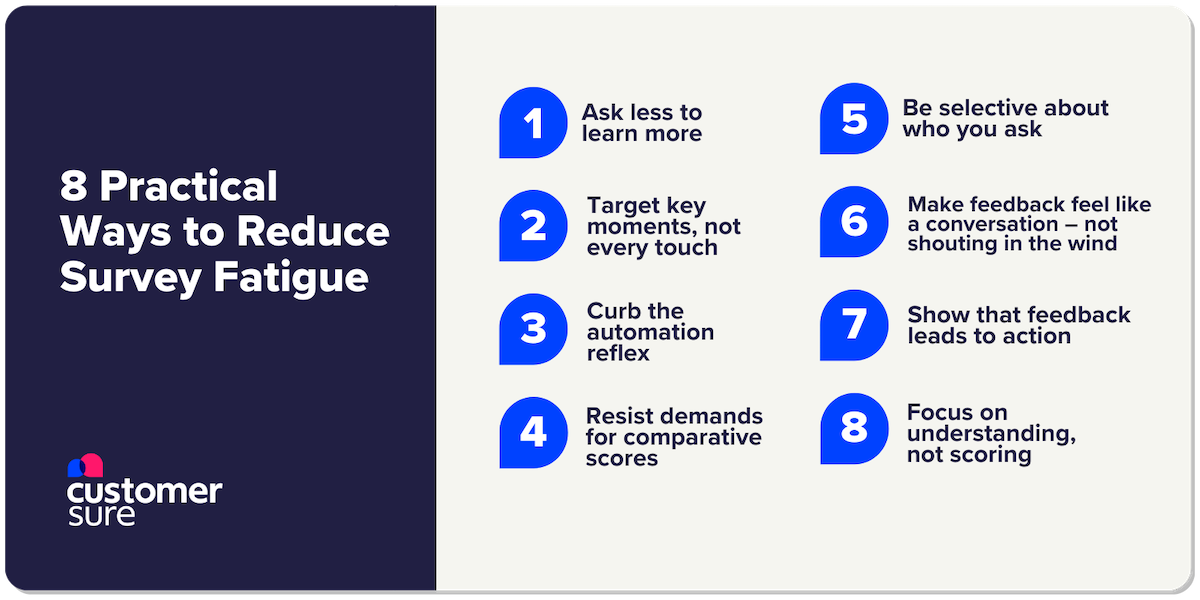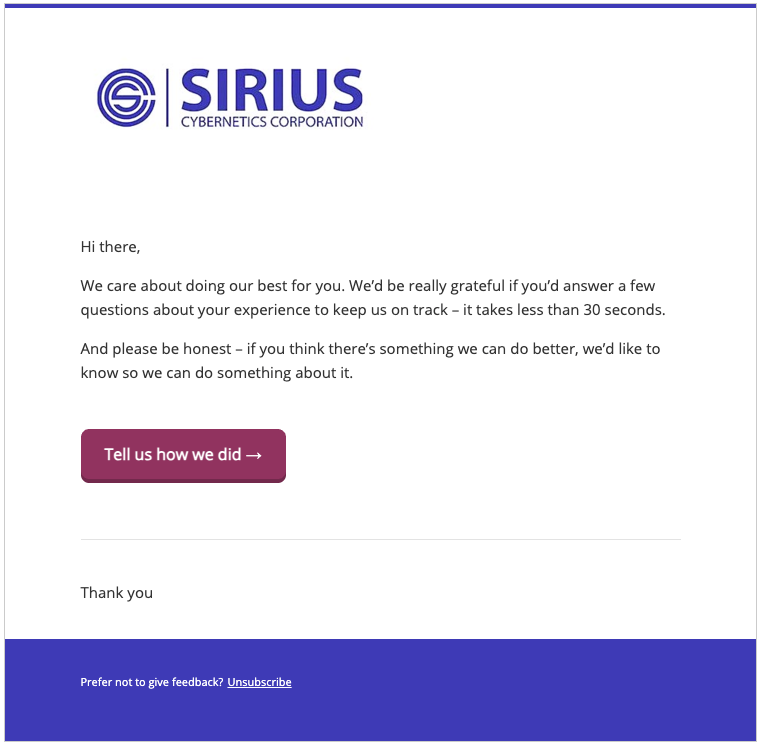In this Guide…
“Customers hate satisfaction surveys.”
It’s certainly true that all of us are bombarded with surveys, to the extent that we often see no value in responding.
Yet the best companies know that customer feedback is essential to success.
We’ll teach you how to get high volumes of good quality data without inflicting a bad experience on customers. Better than that, your feedback process can even become something which your customers love you for.
You may need to change your thinking, but the result will be a win for you and a win for your customers.
Why survey fatigue matters
The fastest growing, most successful and most recommended businesses stack up customers who are loyal and willing to pay more, by delivering an experience which is good and relentlessly consistent.
Without a steady flow of customer feedback, it’s incredibly hard to sustain that level of service.
When response rates drop, you lose the knowledge of what’s most important to your customers. And you lose the cries for help which enable you to reduce churn by stepping in to save customers at risk by intervening quickly.
The truth is that customers do like giving feedback — people would rather tell a company what improvements are needed to keep their business than change to another supplier — as well as the risk of finding that the grass isn’t greener on the other side.
But if you think it through, you only get one shot at it. If a customer gives you the benefit of the doubt, responds to your first invitation to give feedback and finds it to be a bad experience, then what chance have you got that they’ll ever respond again?
You’ll have lost their goodwill and response rates will go into a death spiral.
What causes survey fatigue?
We’ll see that the fundamental cause of survey fatigue, and therefore the solution, is not about issues of survey design or methodology.
Nevertheless, design and methodology mistakes will exacerbate fatigue because customers do hate things like:
- Surveys sent at random times (when a company decides it wants feedback) rather than at relevant points in the customer journey (when the customer is more likely to have feedback that they want to give).
- Surveys which are too long or too complicated – sometimes they even take longer to complete than the interaction they’re asking about.
- Survey questions which are not about the things that are most important to customers. (Choose questions based on what your customers want you to be brilliant at.)
- A headline promise like ‘Win an iPad”, but which 99.99% of people responding are statistically guaranteed not to win.
- Reminder messages – often a knee-jerk consequence of poor response rates, but the effect is that customers feel pestered (which, of course, is not a good customer experience).
- Worst of all, customers hate surveys when they invest time in a considered response, only to feel completely ignored when nobody reads or responds to it. (If you want to offer a prize, consider the fact that this might be the prize that customers want more than a tiny chance of winning a shiny thing).
Despite their obvious shortcomings, these tactics are mainstream so it’s not surprising that we’re all severely fatigued from them.
But even if you fixed all of these individual weaknesses, you’d still have a problem, because the common theme with all of them is that they reflect a counter-productive attitude towards customers. The underlying driver is, ‘We want data from our customers’, not ‘we want to delight our customers’, and that’s exactly how it feels.
People feel like you’re asking them to do some work, for your benefit not theirs.
How to avoid survey fatigue – the breakthrough lesson
The vital change in thinking that’s required is to treat customer feedback as an extra service that you offer your customers. Instead of making it a quest for data for you, build it for their benefit, and make it a brilliant experience!
From a distance the process will look the same. You’ll still be sending satisfaction surveys. But by designing the process from your customers’ perspective, each element will be different – the tone and content of your covering emails, the number and wording of questions, and crucially a well designed follow up process so that customers get the response they might reasonably expect.
The satisfying irony is that designing for the benefit of customers will drive up response rates and improve the quantity and quality of data you receive. So you’ll get more of what you wanted in the first place and your customers will be satisfied with the process rather than fatigued.
Armed with this superior thinking, here’s what you need to do differently.
Eight practical ways to reduce survey fatigue

1. Ask less to learn more
Most companies ask too much because they fear learning too little. Ironically, the opposite is true. One or two smart, well-chosen questions – rooted in what’s most important to customers rather than your pet questions, or what’s easiest to measure – will produce more useful data than a sprawling survey packed with distracting conditional logic.
Customers aren’t unwilling to help; they’re just unwilling to waste time. Treat their time as preciously as your own.
2. Target key moments, not every touch
Feedback has the most value when emotions are fresh – moments of delight, confusion, frustration or surprise. Instead of blanketing every customer interaction with a survey, identify the points in your customer journey where feedback is most meaningful. Pause to ask: “Is this a time when a customer is most likely to have feedback that they want to give?” If the answer is no – or even “not really” – that’s your cue to hold back.
If you only ask when it matters to them, customers are more likely to respond.
3. Curb the automation reflex
It’s tempting to let automation do the heavy lifting – for example triggering reminders. But automation without intention is how you end up nagging your customers. There are at least eleven other things you should try before using reminders!
4. Resist demands for comparative scores
A worry people often express about pruning surveys (that is, making them better for customers!) is that they’ll lose comparative data – the ability to compare a particular satisfaction score now with a particular score, say, last month.
There is a place for tracking satisfaction trends, but it’s much less often than you’d imagine – customers don’t care about your comparatives, they just care about whether you’re meeting their expectations right now. What matters more than the trend is how far the score is below the maximum.
Some comparative scores and trends are important. Not satisfaction scores, but cold, hard business measures – like revenue, profit and customer retention. These are the things that you really want to make sure are getting better and better over time. Satisfaction scores are best treated as a means to that end, they help fix problems to make your business perform better at the measures that shareholders care about.
The danger compounds when you never delete any questions for fear of losing the ability to report period-on-period differences, so you only ever add more questions. Customer experience should always trump the inclusion of scores for comparative purposes.
In fact there’s nothing wrong with pausing or resuming whole surveys from time to time, or adding and removing questions within them. You can shine the searchlight from function to function around the business rather than asking about all of them every time. When an area is performing consistently well and the comments fall to a trickle, dial back on surveys or questions for that area and move on to the next. By the time your focus returns to that area, there may be more to learn again.
Comparatives are always interesting, and that makes them seductive, but unless they enable you to deliver a concrete customer benefit then feel free to drop questions. Your customers will thank you.
5. Be selective about who you ask
Surveying every customer, every time, isn’t just unnecessary – it’s counterproductive. It leads to low response rates and high annoyance. Instead, implement sensible exclusions. Don’t survey someone twice in the same month. Avoid sending follow-ups to customers who’ve already responded.
A good Voice of the Customer (VoC) platform will allow you to configure survey frequencies and sending rules to protect long-term goodwill. They’ll also allow you to override them if you judge that there’s a customer benefit in doing so.
6. Make feedback feel like a conversation – not shouting in the wind
Nothing kills engagement faster than a faceless, boilerplate request. “Please rate your experience” is not a conversation.
In contrast, a personalised message that refers to the customer’s actual interaction – and makes it clear that a real person will read their feedback – can feel like a continuation of your service, not an interruption to it.

An important point to learn is that no matter how well you design your survey, if the covering email or SMS is poorly worded, then the customer won’t even proceed to see your beautifully simple, slimline survey.
Follow these guidelines in your survey invitation:
- Make it clear that it’s short (customers can usually tell you what’s important to them in a survey that takes them 20-30 seconds to complete). If you’re finding that hard, we can help you do better.
- Encourage them to be open and honest, especially if you’re asking about someone’s performance. It can feel awkward giving constructive feedback, but if you frame it as the customer helping you to do a better job for them, they’ll be more comfortable giving a candid response.
- Provide reassurance that someone will read it. This is a mixture of basic courtesy and self interest. Why would someone give feedback if they know it’s going to be ignored? And the benefit to you is that you’ll be able to intervene quickly if necessary and save a customer who might be at risk.
It’s pretty simple psychology – does your email make me feel that I’ll be clicking through to a horror (‘Please fill in our short, ten minute survey’ is disappointingly common), or to a simple and elegant way of telling you what you need to do to keep my business, with at least a degree of confidence that it’ll make a difference?
7. Show that feedback leads to action
Customers don’t get tired of being asked. They get tired of being ignored. If your customers feel like their insights disappear into a black hole, they’ll soon stop responding. Close the loop. Tell them what you’ve changed as a result of their input. Even a newsletter containing examples of “You said, we did” can transform how people perceive your feedback process.
We’re proponents of responding appropriately to all feedback that you receive because we’ve seen the transformational impact it can have on businesses. Not least because this is the real ‘prize’ that customers really want when they respond to your survey – and unlike the iPad, you can reward every customer with this prize.
You might worry that this will mean extra cost or headcount, that’s an understandable concern. But it doesn’t need to be. Careful thought is required, for sure, but it can be achieved by carefully defining and organising roles and responsibilities, not by increasing them. In fact we often help our clients make savings in cost and effort by eliminating problems, improving first contact resolutions and reducing complaints dramatically.
8. Focus on understanding, not scoring
When companies treat surveys purely as a means to populating performance dashboards, they start asking the wrong questions. They obsess over metrics (NPS, CSAT, etc.) and ignore the customer stories behind them. That’s a fast track to shallow insights. Real value lies in understanding not just what your scores are, but why they are what they are – and how to improve them for the people who’ve rated them.
![][image4]
Customer satisfaction should be about people and how they feel, not data and dashboards. That has to infuse the culture – admittedly that’s hard work, because we all love our numbers. Higher scores in themselves represent a hollow victory – you only achieve a genuine return on investment (ROI) when your customers are enjoying a better experience.
How CustomerSure helps avoid survey fatigue
Our Voice of the Customer platform is deliberately simple – because customers don’t respond to complexity. It helps you design elegant, timely surveys that feel effortless to complete, yet deliver insights with real impact. It’s powered by years of hands-on experience helping our clients cut through the noise and focus on what truly drives loyalty, retention, and growth. No gimmicks—just a smarter way to listen, learn, and act.
Is your VoC programme delivering measurable results?
Gain a clear view of how mature your VoC programme is, and receive tailored recommendations to take it to the next level.
Take the assessment »